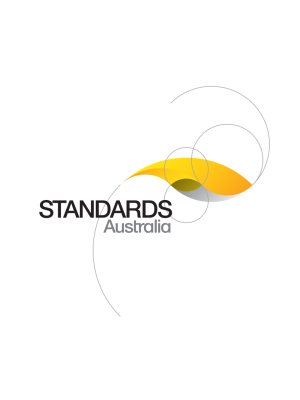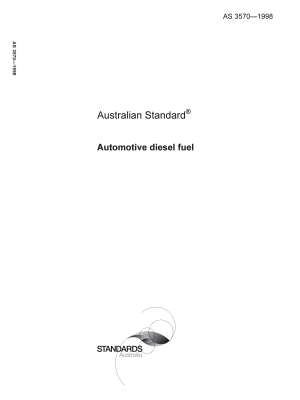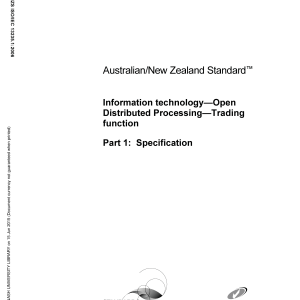🔍

Purchase the full subscription package now and enjoy a 40% discount, along with free updates for future editions.
AS/NZS ISO/IEC 13235.1:2006
$275.61
Information technology — Open Distributed Processing — Trading function, Part 1: Specification
Adopts ISO/IEC 13235-1:2006 to provide a performance model of Open Distributed Processing RM-ODP framework. Definition of an architecture within which support of distribution, interoperability and portability can be integrated. The trading function provides means to offer a service and the means to discover services that have been offered.
Table of contents
Header
About this publication
Preface
Introduction
1 Scope and field of application
2 Normative References
3 Notations
4 Definitions
4.1 Definitions from ITU‑T Rec. X.902 | ISO/IEC 10746-2
4.2 Definitions from ITU‑T X.903 | ISO/IEC 10746-3
5 Overview of the ODP Trading Function
5.1 Diversity and scalability
5.2 Linking traders
5.3 Policy
6 Enterprise specification of the Trading Function
6.1 Communities
6.2 Roles
6.3 Activities
6.4 Policies
6.5 Structuring rules
6.5.1 Community rules
6.5.2 Transfer rules
6.5.3 Delineation of authority rules
6.5.4 Quality of service rules
6.5.5 Matching rules
7 Information specification of the Trading Function
7.1 Overview
7.2 Basic concepts
7.2.1 Interfaces
7.2.1.1 Interface signature type
7.2.1.2 Interface identifier
7.2.2 Service type
7.2.3 Service type subtyping rules
7.2.4 Service offer
7.2.5 Criteria and constraints
7.2.5.1 Matching criteria
7.2.5.2 Preference criteria
7.2.5.3 Scope criteria
7.2.5.4 Edge criteria
7.2.5.5 Trader matching constraint
7.2.5.6 Trader preference constraint
7.2.5.7 Trader scope constraint
7.2.5.8 Trading system constraints
7.2.6 Search request
7.3 Invariant schema
7.4 Static schema
7.5 Dynamic schemata
7.5.1 Export
7.5.2 Withdraw
7.5.3 Modify Offer
7.5.4 Add Edge
7.5.5 Remove Edge
7.5.6 Modify Edge
7.5.7 Add Node
7.5.8 Remove Node
7.5.9 Search
7.5.10 Select
8 Computational specification of the Trading Function
8.1 Viewpoint correspondences
8.1.1 Correspondence with enterprise viewpoint
8.1.2 Correspondence with information viewpoint
8.2 Concepts and data types
8.2.1 Exporter and importer
8.2.1.1 Exporter
8.2.1.2 Importer
8.2.2 Architecturaly neutral types and values
8.2.2.1 TypeCode
8.2.2.2 Nil interface reference value
8.2.3 Service types
8.2.3.1 Service type information
8.2.3.2 Service type model
8.2.4 Properties
8.2.5 Service offers
8.2.5.1 Modifiable properties
8.2.5.2 Dynamic properties
8.2.6 Offer identifier
8.2.7 Offer selection
8.2.7.1 Standard constraint language
8.2.7.2 Preferences
8.2.7.3 Links
8.2.7.4 Policies
8.2.7.4.1 Standardized scoping policies
8.2.7.4.2 Standardised capability supported policies
8.2.7.5 Trader policies
8.2.7.6 Link follow behaviour
8.2.7.7 Importer policies
8.2.7.8 Exporter policies
8.2.7.9 Link creation policies
8.2.8 Interworking mechanisms
8.2.8.1 Link traversal control
8.2.8.2 Federated query example
8.2.8.3 Proxy offers
8.2.9 Trader attributes
8.3 Exceptions
8.3.1 For CosTrading module
8.3.1.1 Exceptions used in more than one interface
8.3.1.2 Additional exceptions for Lookup interface
8.3.1.3 Additional exceptions for Register interface
8.3.1.4 Additional exceptions for Link interface
8.3.1.5 Additional exceptions for Proxy Offer interface
8.3.2 For CosTradingDynamic module
8.3.3 For CosTradingRepos module
8.4 Abstract interfaces
8.4.1 TraderComponents
8.4.2 SupportAttributes
8.4.3 ImportAttributes
8.4.4 LinkAttributes
8.5 Functional interfaces
8.5.1 Lookup
8.5.1.1 Query operation
8.5.1.1.1 Signature
8.5.1.1.2 Function
8.5.1.1.3 Importer policy specifications
8.5.2 Offer Iterator
8.5.2.1 Signature
8.5.2.2 Functions of offer iterator operations
8.5.3 Register
8.5.3.1 Export operation
8.5.3.1.1 Signature
8.5.3.1.2 Function
8.5.3.2 Withdraw operation
8.5.3.2.1 Signature
8.5.3.2.2 Function
8.5.3.3 Describe operation
8.5.3.3.1 Signature
8.5.3.3.2 Function
8.5.3.4 Modify operation
8.5.3.4.1 Signature
8.5.3.4.2 Function
8.5.3.5 Withdraw Using Constraint operation
8.5.3.5.1 Signature
8.5.3.5.2 Function
8.5.3.6 Resolve operation
8.5.3.6.1 Signature
8.5.3.6.2 Function
8.5.4 Offer Id Iterator
8.5.4.1 Signature
8.5.4.2 Functions of Offer Id Iterator operations
8.5.5 Admin
8.5.5.1 Attributes and Set operations
8.5.5.2 List Offers operation
8.5.5.2.1 Signature
8.5.5.2.2 Function
8.5.5.3 List Proxies operation
8.5.5.3.1 Signature
8.5.5.3.2 Function
8.5.6 Link
8.5.6.1 Add_Link operation
8.5.6.1.1 Signature
8.5.6.1.2 Function
8.5.6.2 Remove Link operation
8.5.6.2.1 Signature
8.5.6.2.2 Function
8.5.6.3 Describe Link operation
8.5.6.3.1 Signature
8.5.6.3.2 Function
8.5.6.4 List Links operation
8.5.6.4.1 Signature
8.5.6.4.2 Function
8.5.6.5 Modify Link operation
8.5.6.5.1 Signature
8.5.6.5.2 Function
8.5.7 Proxy
8.5.7.1 Export Proxy operation
8.5.7.1.1 Signature
8.5.7.1.2 Function
8.5.7.2 Withdraw Proxy operation
8.5.7.2.1 Signature
8.5.7.2.2 Function
8.5.7.3 Describe Proxy operation
8.5.7.3.1 Signature
8.5.7.3.2 Function
8.6 Dynamic Property Evaluation interface
8.6.1 Signature
8.6.2 Functions of Dynamic Property Eval interface operations
8.7 Trader object template
8.7.1 Interface templates
8.7.2 Behaviour specification
8.7.2.1 Instantiating interface templates
8.7.2.2 Actions regarding state
8.7.2.3 Combined lookup-register object behaviour
8.7.2.4 Combined lookup-proxy object behaviour
8.7.2.5 Combined admin-lookup object behaviour
8.7.2.6 Combined admin-register object behaviour
8.7.2.7 Combined admin-proxy object behaviour
8.7.2.8 Combined link-lookup object behaviour
8.7.2.9 Combined link-register object behaviour
8.7.2.10 Arbitration action
8.7.2.11 Constraints on the occurence of actions
8.7.3 Environment contract
9 Conformance statements and reference points
9.1 Conformance requirement for trading function interfaces as server
9.1.1 Lookup interface
9.1.2 Register interface
9.1.3 Link interface
9.1.4 Admin interface
9.1.5 Proxy interface
9.1.6 OfferIterator interface
9.1.7 Offerldlterator interface
9.1.8 DynamicPropEval interface
9.1.9 Service subtyping rule conformance
9.2 Conformance requirements for query trader conformance class
9.3 Conformance requirements for simple trader conformance class
9.4 Conformance requirements for stand-alone trader conformance class
9.5 Conformance requirements for linked trader conformance class
9.6 Conformance requirements for proxy trader conformance class
9.7 Conformance requirements for full-service trader conformance class
9.8 Conformance tests
Annex A
A.1 Introduction
A.2 ODP Trading Function module
A.3 Dynamic Property module
Annex B
B.1 Introduction
B.2 Language basics
B.2.1 Basic elements
B.2.2 Precedence relations
B.2.3 Legal property value types
B.2.4 Operator restrictions
B.2.5 Representation of literals
B.3 The Constraint Language BNF
B.3.2 “BNF” for Lexical Tokens up to Character Set Issues
B.3.3 Character Set Issues
Annex C
C.1 Introduction
C.2 The recipe syntax
C.3 Example
Annex D
D.1 Introduction
D.2 Service type repository
D.2.1 Add Type Operation
D.2.1.1 Signature
D.2.1.1 Function
D.2.2 Remove Type operation
D.2.2.1 Signature
D.2.2.1 Function
D.2.3 List Types operation
D.2.3.1 Signature
D.2.3.2 Function
D.2.4 Describe Type operation
D.2.4.1 Signature
D.2.4.2 Function
D.2.5 Fully Describe Type operation
D.2.5.1 Signature
D.2.5.2 Function
D.2.6 Mask Type operation
D.2.6.1 Signature
D.2.6.2 Function
D.2.7 Unmask Type operation
D.2.7.1 Signature
D.2.7.2 Function
Cited references in this standard
Please select a variation to view its description.
| Published | 11/12/2006 |
|---|---|
| Pages | 80 |
Please select a variation to view its pdf.



